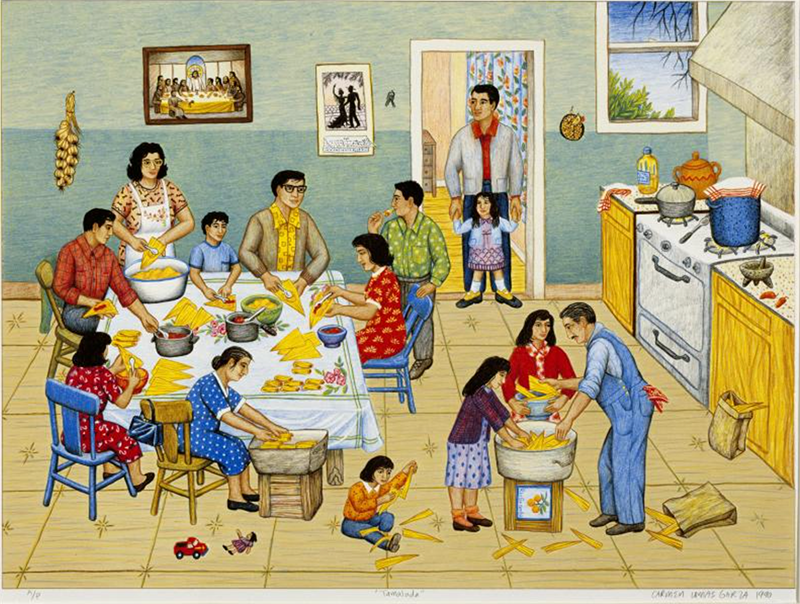Teach This Poem, though developed with a classroom in mind, can be easily adapted for remote-learning, hybrid-learning models, or in-person classes. Please see our suggestions for how to adapt this lesson for remote or blended learning. We have also noted suggestions when applicable and will continue to add to these suggestions online.

Look closely at the image of the painting “Tamalada” by Carmen Lomas Garza.
The following activities and questions are designed to help your students use their noticing skills to move through the poem and develop their thinking about its meaning with confidence, using what they’ve noticed as evidence for their interpretations. Read more about the framework upon which these activities are based.
-
Warm-up: (free-write) What foods are important to you? Why?
-
Before Reading the Poem: Look closely at the image of the painting “Tamalada” by Carmen Lomas Garza. What do you notice in the image? Look again. What else can you find?
-
Reading the Poem: Now, read the poem “Tamales on Christmas” by Christian Robinson silently. What do you notice about the poem? Annotate for any words or phrases that stand out to you or any questions you might have.
-
Listening to the Poem (enlist two volunteers to read the poem aloud): Listen as the poem is read aloud twice, and write down any additional words and phrases that stand out to you. Or, you may opt to watch the video of the poet reading the poem. (Teachers, we suggest pausing the video at 1:18 and sharing the rest of the video later in the lesson.)
-
Small-group Discussion: Share what you noticed in the poem with a small group of students. Based on the details you just shared with your small group and the resources from the beginning of class, how is food important to the speaker? What else does the speaker value?
-
Whole-class Discussion: What do you think about the visual structure of the poem on the page? How did the visual structure impact your reading? What is the poet “not” and why is that important?
-
Extension for Grades 7-8: (Teachers, this prompt is from Respect the Mic.) Write a poem that focuses on how food is important. Share your poem with the class.
-
Extension for Grades 9-12: (Teachers, this prompt is from Respect the Mic.) Use the prompt “Today I am not” to start a poem. Share your poem with the class.
“Rhett Rushing, folklorist at San Antonio’s Institute of Texan Cultures, said tamales have been traditional Christmas Eve fare for centuries because they’re portable, easy to store and inexpensive to make for large gatherings.” Read more about the tradition of making tamales on Christmas with this article from NPR.
This week’s poetic term is caesura, or a pause for a beat in the rhythm of a verse, often indicated by a line break or by punctuation. Read more.
